Have you heard about grounding or earthing shoes? These unique footwear items have gained popularity in the wellness community, and many people wonder if they should try them. We’ll explore what grounding shoes are, how they work, and whether science supports their use.

What Are Grounding Shoes?
Grounding shoes (also called earthing shoes) contain special conductive materials like copper or carbon in their soles. These materials create an electrical connection between your feet and the Earth’s surface. Manufacturers design these shoes to mimic the experience of walking barefoot while protecting your feet.
How Do Grounding Shoes Work?
The concept behind grounding shoes is simple. When you walk barefoot on natural surfaces, your body makes direct electrical contact with the Earth, potentially helping your body improve its natural electrical balance. Regular shoes block this connection with their rubber soles. Earthing shoes try to restore this connection through conductive materials that run through the sole.

Why Have Grounding Shoes Become Popular?
The growing enthusiasm for grounding shoes reflects a broader shift toward natural wellness approaches, though it’s worth examining the various factors at play:
The Minimalist Shoe Connection
Many grounding shoes also function as minimalist or barefoot-style shoes, which means they typically feature:
- Wide toe boxes that allow natural foot spread
- Thin, flexible soles that enable better ground feel
- Zero drop design (no height difference between heel and toe)
- Lightweight construction that encourages natural movement

These design features alone can provide significant benefits:
- Improved foot strength and mobility
- Better posture and balance
- More natural walking patterns
- Enhanced proprioception (awareness of foot position)
It’s possible that some of the positive experiences users report with grounding shoes stem from these minimalist design features rather than the grounding technology itself.
Other Factors
Beyond the physical design benefits:
- Personal Success Stories: Users share positive experiences with grounding shoes, reporting improved sleep, reduced stress, and a greater sense of wellbeing. Because this is an emerging trend, anecdotal evidence like this article’s author touting sleep improvements and improved sensory connection to the ground is fueling the demand for earthing shoes.
- Rising Interest in Natural Health: Many people want to reconnect with nature as our lives become more technology focused. Earthing shoes offer a way to maintain this connection while living a modern lifestyle.
- Wellness Industry Growth: The global wellness industry continues to expand, and products that promise natural healing often gain attention.
- Social Media Impact: People frequently share positive experiences with grounding shoes online. These personal stories, even if they reflect placebo effects, help drive interest in the products.
- Minimalist Shoe Connection: Many earthing shoes also follow minimalist shoe design principles. People might experience benefits from the natural foot movement these shoes allow, even if the grounding effect plays a minimal role.

What Does the Research Say About Grounding?
Scientists have conducted several studies on grounding. Here’s some of what researchers have found:
- A 2004 study in the Journal of Alternative and Complementary Medicine looked at how grounding affected cortisol levels. This small-scale study with 12 participants suggested that grounding might regulate daily cortisol levels, potentially offering stress-reduction benefits.
- A comprehensive review appeared in the Journal of Environmental and Public Health in 2013. The researchers looked at various potential benefits of grounding, including effects on inflammation, sleep quality, and pain levels. The review confirms promising results but emphasizes the necessity for more extensive research to fully understand these effects.
Should You Try Grounding Shoes?
Recent user experiences have been particularly encouraging. For example, many wearers report better sleep quality and a stronger connection to their environment. While individual results vary, the growing number of positive testimonials suggests these shoes might offer real benefits for many users.
- Before investing in earthing shoes, try walking barefoot on grass for a few minutes each day to experience the basic concept of grounding.
- Consider testing regular minimalist shoes first. Since many reported benefits might come from the barefoot-style design of the shoes rather than the grounding technology, you might get similar results from standard minimalist footwear without paying for the copper plug.

Important Things to Know Before Buying
Before you spend money on grounding shoes, consider these key points:
They Only Work on Certain Surfaces
Grounding shoes will only create an electrical connection when you walk on:
- Natural soil
- Grass
- Sand
- Unsealed concrete
The shoes won’t provide any grounding benefits on:
- Wood floors
- Carpet
- Sealed concrete
- Asphalt
- Most indoor flooring
Do They Increase the Chances of Being Struck by Lightning?
The size and scale of a lightning strike are such that the presence of a small piece of copper in your shoe would not make a difference. Lightning seeks a path to the ground via the highest and most conductive objects available.
The bottom line is you shouldn’t walk around outside during an electrical storm, period.
Popular Brands of Grounding Shoes
If you’re intrigued and want to experience grounding shoes for yourself, here are some of the more popular options:
- Earthing Harmony – Customers generally appreciate the design and comfort of these grounding shoes, noting a reduction in aches and pains. However, some express concerns about durability, as toenails may leave marks, and the shoes are not suitable for wet weather due to non-weatherproof soles.
- Harmony 783 – Customers appreciate the comfort and fit of the footwear, though some customers experienced durability concerns. The grounding functionality is appreciated, with reports of better sleep and comfort. Some users note the unique issue of soles causing black residue.
- Bahe – Bahe customers generally appreciate the comfort and design of their shoes, though sizing issues are a common concern. Many find the shoes to be great for grounding and everyday wear, but challenges such as ankle rubbing, the need for half sizes, and width discrepancies affect overall satisfaction.

The Bottom Line
While scientific research continues to explore grounding benefits, many users report positive experiences with these shoes. The growing market and numerous success stories suggest there might be more to grounding than initially meets the eye. However, it’s important to recognize that these benefits might come from a combination of the minimalist shoe design and the grounding technology.
More from Bananomad
- Learn which seed oils might be affecting your health and why. Find out the list of seed oils to avoid, where they hide in food, and better alternatives.
- Explore 25 essential ebike accessories to improve your ride, blending top safety, comfort, and performance features.
- Explore our expert advice on what to pack in a carry-on bag. From clothing to toiletries, we’ve got you covered for any type of trip.


Leave a Reply